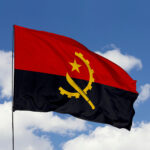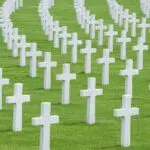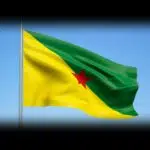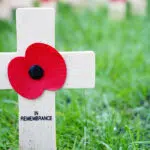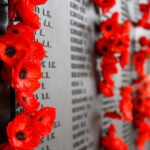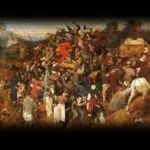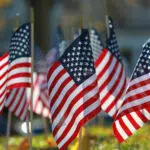The island of French Guiana observes Armistice Day every November 11 to honor the soldiers who fought for the French during World War I. In particular, the holiday commemorates the armistice agreeing to cease all war activities signed by the Allies and Germany. Armistice Day is a significant holiday for all Allied countries and Commonwealth members, many of whom observe this day on November 11.
History of French Guiana Armistice Day
The devastating bloodshed of World War I found its end following the armistice signed by the Germans and the three Allies — France, the United Kingdom, and the United States. On November 11, 1918, representatives from both sides, including Marshal Ferdinand Foch for the Allied Forces, Admiral Rosslyn Wemyss of the U.K., and Matthias Erzberger of Germany, met in a train’s restaurant carriage parked in the Rethondes Clearing of France’s Compiègne Forest. The armistice signing early in the morning resulted in the cessation of fighting at the Western Front from 11 a.m. that same day, dubbed the “eleventh hour of the eleventh day of the eleventh month.”
Sporadic hostilities continued in certain parts of the world even after the armistice was signed, especially in the former Russian Empire and parts of the old Ottoman Empire. The war and related conflicts officially ended with the signing of the Treaty of Versailles on June 28, 1919.
For the people of French Guiana, conscripted to the war like other French colonies, the fighting on the Western Front was a matter of great pride. Their troops had been honored in the war and were recognized as a valuable part of the French army and a significant contributor to Germany’s defeat in the region. Today, every citizen of this French region proudly pays tribute to the soldiers of World War I, remembering them in parades, military activities, and other official events.
French Guiana Armistice Day timeline
Canadian Lieutenant-Colonel John McCrae’s “In Flanders Fields,” a poetic account of the war and the sacrifices of all those who fought in it, is published.
Representatives from Germany and the Allies sign the armistice, halting fighting on the Western Front.
The first official Armistice Day observation is held at Buckingham Palace, London, and King George V calls for a two-minute silence in remembrance of war casualties.
French Guiana’s 3rd Foreign Infantry Regiment commemorates the 100th anniversary of Armistice Day by remembering the Foreign Legion Regimental Combat Team (R.M.L.E.), who fought on France’s Western Front and became the French Army’s most decorated unit.
French Guiana Armistice Day FAQs
Do any other countries wear poppies?
Poppies signify remembrance among the Commonwealth of Nations, namely Australia, Canada, New Zealand, and the U.K. They are also used to some extent in the U.S.
What is the difference between Armistice Day and Veterans Day?
Veteran’s Day is the American nomenclature for Armistice Day and honors the veterans of the U.S. Armed Forces. It is also observed every November 11.
Why are there two minutes of silence for Remembrance Day?
Sir Percy Fitzpatrick proposed the two-minute silence as a mark of respect. The suggestion reached King George V, who eagerly implemented it on the first anniversary of the armistice in 1919. Some people also attribute the silence to Melbourne journalist and World War I veteran Edward George Honey, who proposed it in a letter to a London newspaper in 1919.
How to Observe French Guiana Armistice Day
Watch a World War I documentary
See how the war impacted every country, mainly the colonies asked to send men into a war that wasn’t theirs. Listen to accounts from researchers and veterans about the effects of war and the impact of the armistice.
Visit a war memorial
War memorials exist in many places touched by the bloodshed. Plan a trip to visit war memorials near you to pay your respects.
See the battle sights
Take a trip to the sites of significant battles. You can also visit museums featuring World War I memorabilia to learn more about life during this difficult period.
5 Facts About Poppies And World War I
They’re an important symbol
Poppies grew in large numbers across parts of Belgium, where many critical battles were fought.
They were nourished by destruction
The soil in France and Belgium became enriched with lime from all the debris and rubble World War I left, resulting in the widespread growth of poppies in these regions.
The color are symbolic
Like the poppies, red was a sign of hope to the battle-fatigued soldiers.
Poppies were sent home
Soldiers fighting in Belgium often took advantage of the fields of poppies, sending pressed poppies home in letters.
Australians use rosemary instead
Australians substitute poppies with rosemary, an ancient symbol of remembrance, to remember their fallen on their Remembrance Day.
Why French Guiana Armistice Day is Important
It’s about remembrance
World War I saw 20 million deaths and even more wounded. French Guiana Armistice Day gives us a chance to remember the lives and sacrifices of these people.
It has evolved
Over time, French Guiana Armistice Day commemorations have expanded to include all war casualties, whether World War I, World War II, or the Iraq Wars. The day honors everyone who fought to keep their loved ones safe.
It celebrates the end of war
While we’re grieving the massive loss of life World War I wrought, we are also thankful to the events of November 11, 1918, for bringing about the end of this conflict. If not for the armistice, more lives would have been lost.
French Guiana Armistice Day dates
| Year | Date | Day |
|---|---|---|
| 2025 | November 11 | Tuesday |
| 2026 | November 11 | Wednesday |
| 2027 | November 11 | Thursday |
| 2028 | November 11 | Saturday |
| 2029 | November 11 | Sunday |

